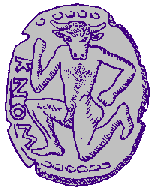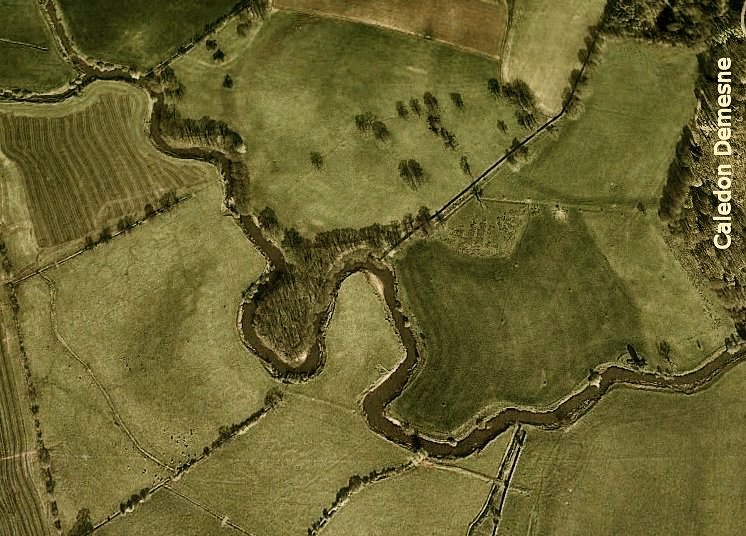anticopyright
2015
Anthony Weir
THE
BONE-HOUSE,
CALEDON, COUNTY TYRONE,
Northern Ireland
|
Popularly believed to have been built of the bones of cattle slaughtered by the victorious army of Owen Roe O'Neill (Eoghan Rúadh Uí Níall) in 1646, over the Puritan English and Scottish troops (6000 foot and 800 horse) of General Monro[e] at Benburb, not far from Caledon, during the 'Ulster Rebellion',The Hermitage, however, was built as a folly or belvedere by the Earl of Cork and Orrery. His wife was Margaret Hamilton. heiress to the Caledon Demesne (Estate), part of Owen Roe's territory which, after the collapse of the Ulster Rebellion and the Cromwellian victories in Ireland, was granted to Scottish Lowlander Captain William Hamilton in 1660. It was then that the townland of Kinard/Kennard (Ceann Árd) was renamed and the village of Caledon (a poetic name for Scotland) was 'planted' on the site of an O'Neill castle. In the Orrery Papers, under the date of June 24th 1747, the following letter from the fifth Earl of Cork and Orrery (Fellow of the Royal Society and a friend of Jonathan Swift, Alexander Pope and Samuel Johnson) to the 'Rev. Mr. F.' appears, referring first to a Bonery ordered to be built by Mary Assheton,Lady Curzon, (about which I can find no web-reference) : "I then desired you, and I again desire it, that you will, if possible, obtain from Mr. Poole, or by whatever other method you think proper, an exact description of that ossified edifice. Let me know the size of it. The sort of bones. "The method of putting them together. "In short, all particulars relating to ossification." "We came to the resolution of building a Bonery, to strike the Caledonians with wonder and amazement by fixing an Ivory Palace before their view. We have already gathered great numbers of bones, and our friends the butchers and tanners of Tyrone have promised to increase the number" [the number of dogs notwithstanding]. "We have built, at the expence of five pounds, a root house, or hermitage, to which on Sunday the country people resort, as the Londoners to Westm[inste]r Abbey. For gayer scenes, I have a lodge near a mile distant from the hermitage, and large enough to contain a good number of friends at dinner or supper, or to entertain eight couple with a country dance. Behind this room are three little rooms, a kitchen, a bedchamber, and another room, besides a cellar. buildings are in the form of Buckingham House." Tyrone, the county, is in Irish Tír Eoghain - the Territory of Owen. The Caledon Estate on the southern edge was later bought by the Alexander family who were bestowed the Earldom of Caledon, and had built a Georgian mansion a mile down the Blackwater River from "The Bone House", which was beside the river on the county Tyrone side – the other side being county Monaghan in the Irish Republic. In 1775-6 the 9,000 acre Caledon Estate was bought by the Right. Rev. Dr. Nathaniel Alexander who became Earl of Caledon in 1800. Between 1806 and 1811 this first Earl (appointed Governor of South Africa) spent over £17,000 (£600,000 at 2020 value) when he employed the celebrated English architect, John Nash, to repair Caledon House and extend it. His colonnade is much admired.
Although even then somewhat Beyond-the-Pale, I was once invited to The Big House to make a spinach soufflé for the Countess...
Below are (probably) the last sad remnants of Orrery's Ossuary and Ivory Palace (actually a single room) : a chunk of cemented bones which fell further apart, despite my care in moving them. |

click the picture to enlarge
![]()
THE
BONE HOUSE, CALEDON 1969
near which I lived for a year
from
Cinema of the Blind, by Anthony
Weir
Blackstaff Press, Belfast 1971
Near my
house and up the river
in a field scattered with stones:
a line of trees that sway and shiver,
and Bone House - ruined room of bones.
Beside
the trees that sway and shiver
ten thousand femurs made a single room
where fallow-deer cavort and quiver
and the brambles arch and bloom.
Where fallow
deer cavort and quiver
a man stands staring at the view
among the bones that old men severed
from the oxen young men slew.
Among the
bones that young men severed
prowls his cage of living bone:
a hermit in his skull forever
rarely sad to be alone.
A hermit
in his skull forever
stares from windows brightly stained
by fancies flowing like the river
through a landscape it has drained.
Fancies
flowing like the river
by this arcane, brittle place
conjure butchers and their lovers
jerking in their brief embrace,
conjure
butchers and their lovers
briefly joined by flesh to flesh
among the mortared bones long severed.
Bloody fancies briefly threshed
among the
mortared bones long severed
by the butcher's searching knife,
and, since then, I have endeavoured
to make nothing of my life.

an abandoned house in Caledon >>>
|
|
|
this site
only |





